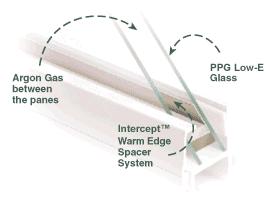Windows and doors energy efficiency

What is ENERGY STAR®?
ENERGY STAR is a voluntary partnership between the U.S. Department of Energy,
the U.S. Environmental Protection Agency and the fenestration industry.
It is designed to assist consumers in the recognition of energy efficient products and promote the environmental and economic benefits of these products with the ENERGY STAR label and other program activities.
How do products qualify for ENERGY STAR?
Consumer products (such as major appliances) receive the ENERGY STAR label
when they exceed the minimum federal energy consumption standards. These
figures vary from product to product.
How do windows qualify for ENERGY STAR?
Window products qualify by meeting certain criteria set forth by the National
Fenestration Rating Council (NFRC).
All windows must be NFRC rated, certified and labeled for both U-factor and Solar Heat Gain Coefficient as well as Visible Light Transmittance.
What is a U-factor?
A U-factor measures the rate of non-solar heat transfer from one side of the
window to the other. Heat transfers to both heat loss out of a living space
during cold winter weather and non-solar heat gain into a living space during
hot summer weather. This energy transfer, measured in BTUs, is know as conduction.
The lower the U-factor of a window, the higher it's R-value.
And what is Solar Heat Gain Coefficient?
The Solar Heat Gain Coefficient measures the amount of solar heat that gets
through a window. The lower the SHGC, the better a window is at reducing
heat gain, and in the end, the cooling costs that go along with it.
What is the NFRC?
The National Fenestration Rating Council is a non-profit, public/private organization
created by the window, door and skylight industry. Their primary goal is
to provide accurate information to measure and compare the energy performance
of window, door or skylight products.
What are those qualifications?
The program has established three climate regions with one recommended product
designation for each:
Northern Region Criteria
Windows must have a U-factor rating of 0.35 or below.Central Region Criteria
Windows must have a U-factor rating of 0.40 or below. . . With a Solar Heat Gain Coefficient (SHGC) of 0.55 or below.Southern Region Criteria
Windows must have a U-factor rating of 0.75 or below. . . And an SHGC of 0.40 or below.
What's so special about Insulated
Glass?
 Since
70% of a window is glass, real energy savings come from improved glass performance.
Since
70% of a window is glass, real energy savings come from improved glass performance.
Low-E Glass and gas filled IG significantly improves energy efficiency and cuts the damaging effects of the sun by an additional 78% over clear insulated glass units.
 In
winter, it lets in maximum free solar heat and helps hold warm air inside,
increasing R-value by over 100%.
In
winter, it lets in maximum free solar heat and helps hold warm air inside,
increasing R-value by over 100%.  In
summer, an additional 48% solar heat gain coefficient helps cut air conditioning
costs.
In
summer, an additional 48% solar heat gain coefficient helps cut air conditioning
costs.
How does Insulated Glass save you money?
The average household spends over 40% of its annual energy budget on heating
and cooling. Windows we recommend can reduce those bills up to
15% or more. Energy-saving Insulated Glass helps cut the amount
of fossil fuel used while helping reduce air pollution, smog and global warming.
Why is this so important to our country and our world?
If all residential windows in the U.S. were replaced with ENERGY STAR compliant
products. . .
- We would save $7 billion in energy costs over the next 15 years.
- The reduction in carbon emissions would be the same as taking 336,000 cars off the road.
- We could preserve 142,000,000 acres of trees over the next 15 years.
Why is ENERGY STAR so important?
This recognition is granted only to the most advanced, energy-efficient products
on the market.
Watch for the ENERGY STAR logo popping up on all of the following products. . .
- Consumer appliances
- Light fixtures
- Computer Equipment
- Windows
- ...any item that offers superior efficiency in the conservation of energy.
Why is ENERGY STAR so important to you?
You can enjoy
the knowledge that you're helping to make a positive impact on your environment.
For more information about ENERGY STAR and other energy savings related
activities and opportunities:
www.energystar.gov
www.efficientwindows.org
www.nfrc.org
The average household spends over 40% of its annual energy budget on heating and cooling.


